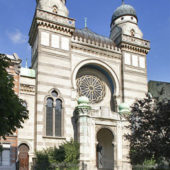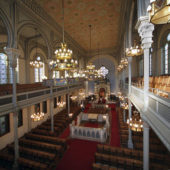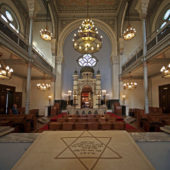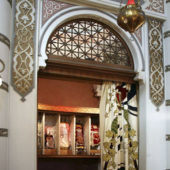The Hollandse Synagogue, or Dutch Synagogue, is so named because it was built by the descendants of Jews who came to Antwerp from Holland in the early 19th century.
Jews have been in Antwerp, Belgium for at least 800 years. The first documentation of Jews in Antwerp is found in the will of Henry III, Duke of Brabant and Margrave of Antwerp. In his will, he said that he wished the Jews would all be expelled and destroyed because they were all considered “usurers.” In the mid 14th century, John III, Duke of Brabant, instigated a huge anti-Jewish campaign in Brussels and Leuven, driving the Jews from the cities. In the early 16th century a new influx of Jews from the Iberian Peninsula fleeing Catholic persecutions settled in Antwerp. It was a relatively safe haven over the following 150 years; however, they were not allowed to become citizens and were frequently persecuted. In 1794 Jews were finally allowed to freely settle in Antwerp, due to the French Revolution and its subsequent Jewish emancipation. In 1816 an official community of approximately 150 Jews was established in the city, known as the Communauté Israelite (Jewish Community).
The first communal Jewish prayers were said in the home of Moise Kreyn, which was approved by the city authorities. In 1828 the Jews of Antwerp acquired a cemetery. In 1829 the Jewish population in Antwerp numbered 151. Prior to WW II, the number of Jews in Antwerp rose to approximately 35,000. During WW II, 65% of the Jews perished in the Holocaust, leaving only 15,000 in the city after 1945. On April 14, 1941, the “Antwerp Pogrom” occurred, when 200 Flemish Nazis supporters burned down two synagogues in the Oosten straat. From May through September of 1942, 1500 Jewish men from Antwerp were abducted into forced labor in Northern France to help build the “Atlantic Wall” for the Todt organization. On three occasions from the end of July through November of 1942, Jews in Antwerp were rounded up by the Germans, with the collaboration of the local police.
Today, the community of Jews in Antwerp totals 15,000, who largely identify themselves as belonging to either the traditional or Orthodox communities, with 30 Orthodox synagogues. Because it is such a large community, one of the largest in the Diaspora, it is sometimes regarded as the last shtetl in Europe. Over 80% of the Jews in Antwerp are engaged in the city’s diamond trade and Yiddish is the language of the trade, although English is also becoming increasingly important to learn as well. The Jewish community of Antwerp is a self-contained entity. Approximately 95% of the children attend Jewish day school and receive intensive religious education. Flemish is the primary language and the language of instruction; however, the children are also taught Hebrew and Yiddish for prayer and cultural purposes, as well as French and Belgium as “second” languages.
The Hollandse Synagogue, or Dutch Synagogue, was built by descendants of Jews who immigrated to Antwerp from Holland in the early 19th century. It was the first large synagogue in Antwerp. Jewish architect Joseph Hertogs designed the Synagogue and it was inaugurated in 1893. It was designed in the Moorish Revivalist style, the façade featuring tripled arched windows, two sets of towers with onion shaped domes flanking a large round stained glass window, two colors of bricks used to create a striated effect, and detailed Moorish motifs. The interior of the prayer room is breathtaking. Ivory walls are offset by stained glass windows framed in wood casings, and sweeping light blue arches supporting the women’s galleries in light blue paneling with a wrought-iron grill run along the sides and back of the sanctuary. The arches taper down to light blue columns on the ground floor. Large Moorish-styled stained glass windows adorn the side walls upstairs. The ceiling is spectacularly hand-painted in a Moorish motif in peach, ivory and light blue. A large chandelier drops down from the center of the ceiling and smaller chandeliers light the rest of the sanctuary. The Aron-Kodesh on the raised platform at the front of the prayer room resembles an intricately decorated mosque. Exquisite in its design, the main body is ivory, with the center “onion dome” in slate gray and the two smaller onion domes on either side, the same color. Beautiful motifs and carvings in grays with gilding enhance its beauty. Inside the opening sit the Torah scrolls on various shelves. An ivory Torah curtain, which is decorated in many colors, is drawn to the side. A hand-carved wood screen is inserted at the top of the arched opening. A brass incense holder drops from the ceiling in front of it. A magnificent window of Moorish design and detailed woodwork is behind the Aron-Kodesh. Across the front of the platform is an intricately designed balustrade carved of white marble, with slate gray decoration. The tivah (reader’s desk) sits in the center of the sanctuary, featuring panels carved out of white marble in a square shape with slate gray decorations, with openings on either side for the speaker to enter.
Hollandse Synagogue suffered significant damage in WWII, but was completely restored to its original appearance in 1958. Today, this Orthodox Synagogue is used for services only on Rosh Hashana and Yom Kippur. Unusual in an Orthodox synagogue, there is a pipe organ in the balcony. Hollandse Synagogue has been a protected monument since September 17, 1976.





